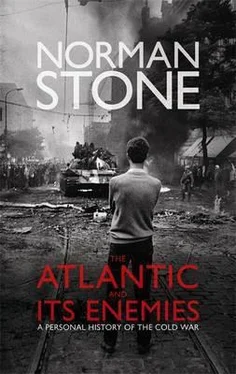Reagan was of course helped, as ever, because his opponents underrated him. Carter was even quite pleased at the nomination of a washed-up actor with eccentric political views. But it was Reagan who won the exchanges. Carter mocked him, saying the economy was in depression; what he meant was ‘recession’ but did not know the difference. Reagan was quick off the mark: ‘A recession is when your neighbour loses his job. A depression is when you lose yours. And recovery is when Jimmy Carter loses his.’ Of course the establishment — what Vladimir Bukovsky calls the new American elite — did not like this but, in the event, the election gave Reagan a comfortable victory. Carter then went off to obscurity, subsequently returning in the 1990s to inform the world that North Korea would agree not to develop nuclear weapons or that Haiti would turn into a proper democracy, announcements very rapidly falsified by events. With this hapless figure, the sixties came to an end.
In January 1981, as he took over, Reagan announced that there should be tax cuts and a reduction in domestic spending; he promised prosperity. However, as with Margaret Thatcher though for different reasons, he ran into problems. There were severe enough limitations on his power but in any case the ‘conservatives’ were implicitly divided and this showed, after initial reverses. Reagan had pledged to cut public spending, and blamed it for many ills, including inflation; at the same time he had promised to cut taxes. There was a difficult context, because interest rates (at almost 20 per cent) were so high. Private enterprise could no doubt take up slack that came from a reduction of public spending, but not if credit were so expensive: any small business would need it to keep going. Besides, Reagan was not the only wielder of power: there was a Democrat-majority Congress, there were separate states with spending rights, and there was a legal system of fabulous interferingness. Public opinion was a constant concern, and the media thereby seemed to have enormous importance — the maker and breaker of presidencies. Besides, any President would inevitably find himself dealing with foreign affairs — one complication after another, with vociferous lobbies attached. Not an easy set of cards to play.
Divisions emerged rapidly enough. Jack Kemp especially had been arguing that tax cuts would more than pay for themselves. This was a popular enough cause. The average family income in 1970 was under $10,000, and as that figure, on paper, rose, the tax rate went up by 20 per cent, though the average income in 1980 was buying about 20 per cent less than in 1970. In, say, Germany, the high taxes at least bought decent public services. Not, for the most part, in the USA. However, there was a vast constituency for social security, especially Medicare and Medicaid, the costs of which went up and up (while also leaving millions of people without health insurance). There were also endless lobbies for this or that subsidy, especially the farmers: a cow cost $2 per day, before it had even started to chew the cud or be milked. A very tortuous campaign went ahead, through a Democrat-dominated Congress (with a slight and unreliable Republican majority in the Senate). Reagan turned out to be a very astute manager. His style was less than hectic: he refused to do early-morning meetings. The team that he had chosen spoke with different voices: a James Baker, more or less in conventional mould, could, as Chief of Staff, talk lobbyists’ language, whereas a David Stockman, managing the budget, addressed fears as to deficits. Reagan could also use television as a professional, and outflank Congress in that way, with an appeal to public opinion. Above all, he did not preach or offend, and his relations with the Democrat Speaker, Thomas ‘Tip’ O’Neill, were friendly. In 1981 legislation brought a tax cut of 25 per cent, in slices — 5 per cent at once and 10 per cent for the next two years. The top rate of tax fell from 70 to 50 per cent and by 1985 tax was supposed to be indexed against inflation. By 1988 the top rate had fallen to 28.5 per cent. There were concessions elsewhere, for retirement savings and the like. So far, so good. Reagan was also shown to be right as to the effects: the better-off did not avoid tax, and income from them went up, not down. In 1986 a new tax law brought the marginal rate down from 50 to 28 per cent but cut out some loopholes, and there were only three tax brackets. However, business and other taxes did in effect rise.
David Stockman, at the Office of Management and Budget, was a man of fiscal rectitude, and he could see an immediate problem: a deficit. It stood at $50bn in 1980, and under Reagan, by 1986, reached $200bn. When he left office, the overall debt had increased by $1,500,000,000,000 (1.5 ‘trillion’, though the word is not correct). Stockman was a free-market convert (originally from the radical Left) and set himself to attack ‘forty years… of promises, entitlements and safety nets’, i.e. the welfare state as it had grown up since Roosevelt’s time. The problem here was not just the poor, for whom the welfare state had been designed. There were many middle-class ‘entitlements’ as well, and the health schemes were notoriously prodigal. There were also arrangements to subsidize the buying of houses on mortgage — great federal institutions, quite strictly regulated. Meanwhile, Reagan himself had encouraged the Defense Department to put up its budget, and according to Stockman, its Secretary, Caspar Weinberger (one of Reagan’s Californians) in effect dictated government finances. Stockman talked to congressmen with a view to having taxes put up, not down, because of the deficit and ‘leaked’ news that he had sabotaged the tax cuts, but Reagan did not dismiss him until 1986, when Stockman went on to Wall Street. His memoirs are a long statement of contempt: both for the endless political subsidization (‘pork barrel’) that went on, sometimes by small-print subterfuge, and for Reagan’s own management, which he thought very weak and even reckless. Military spending took priority, and from 1981 to 1987 went up from under $200bn to nearly $300bn. But it was not just defence: Stockman catalogues case after case of special pleading, as each congressman expected a favour or two in return for his vote. His was a curiously unstable career — Harvard theology, the anti-Vietnam Left, free-marketeering, money on Wall Street and, in 2007, an indictment for fraud.
At any rate, he could not convince the powers that be, and became a fifth wheel. The Reagan administration went along with social spending. There were ‘cuts’ — in 1981 $35bn, as food stamps and student loans were cut back. A redundant employment agency was closed down and fuel prices were freed. These ‘cuts’ were overall rather trivial, but, as ever in this period, there were dramatic howls. Even Daniel Moynihan talked of ‘devastating cuts’ and a well-known liberal economist, Robert Reich, said that it was ‘the return of Social Darwinism’ — the same hysteria as appeared in Britain. But Reagan could not cut back significantly: he went on spending, and could afford to do so because the GNP rose by a third — equivalent to the entire German economy. David Frum ( Dead Right ) is scathing. He notes that Reagan’s old Californian associate Edwin Meese, though supposedly overseeing the entire administration from the ‘conservative’ angle, and subsequently Attorney-General, wasted time, ran an office of legendary confusion, and protected spending programmes from Stockman’s axe — orange-growers, for instance, who were very firmly regulated as to how much each could produce. In February 1981 he trumped Stockman by announcing that all the chief programmes (Medicare, etc.) would be safe. In the same way, the despised Department of Education was not closed down, as had been, to wide enthusiasm, promised. Carter had rewarded his teacher allies with it, and the Reagan allies regarded it as pernicious. But on it went, to a budget of over $20bn in 1989: it was a useful field for patronage, particularly its Civil Rights side. William Bennett, an interesting thinker, was put in charge, and went around making speeches that electrified audiences, but his department blithely went on as before, with bussing schemes and federal instructions as to how schools should teach. The budget went up from 1981 to 1989 and the rise accounted for three quarters of the 50 per cent increase in federal education spending. Yet America’s educational performance went down, at any rate as far as schools were concerned. Literacy was barely above the level of poor countries, although spending was considerable. Perhaps the worst case occurred with farmers. They had borrowed to buy land in the 1970s and then faced high interest rates, with declining prices for land and crops. The government offered credit to a maximum of $2.5m per farm, and even forgiveness, and the extra $20bn farmers received in 1986 was three times the federal contribution to families with dependent children. Overall, spending rose from $808bn to $1,114bn. Reagan’s own record looked somewhat better, in terms of government share in GDP, only because some big bills — the savings and loan debacle — came in after he had gone. He had said that he would try to undo, not the New Deal, but the Johnson Great Society. However, an essential part of that had been Medicare, which paid most of the health costs of the elderly, over sixty-five, even when they were not at all poor. This had cost $64m when it began in 1966, and reached $32bn in 1980 and over $200bn by 1997. The usual explanation for this was that medical technology and drugs had a higher inflation rate than anything else, although quite why was not easy to see: usually, technology depressed costs. Reagan had begun by denouncing socialized medicine as likely to end up with problems of this sort, but, once in office, he of course could not attack such a large and powerful constituency, and, as happened with variations anywhere else, was reduced to tinkering with cost caps. By 1993 Medicare alone took 11 per cent of all federal revenue, having grown at 12 per cent per annum. Besides, the huge inflow of Medicare money made every other form of health care more expensive, and employers were paying more into the system instead of raising wages and giving people money to spend directly, which might have caused them to question costs. Here was a monster out of control.
Читать дальше












![Edward Ellis - Adrift on the Pacific - A Boys [sic] Story of the Sea and its Perils](/books/753342/edward-ellis-adrift-on-the-pacific-a-boys-sic-s-thumb.webp)